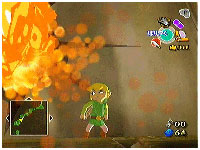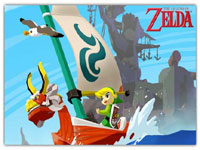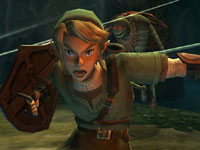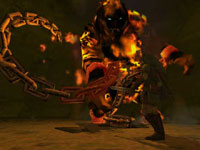Bonnie Ruberg is a staff writer for Planet GameCube and Gaming Age, a freelance games journalist, and the author of
Heroine Sheik, a blog dedicated to investigating sexuality in gaming cultures. Today, we have the pleasure of running a piece she's written for the site about a topic that's been brought up more than once in the comments here on Slashdot.
"For Zelda fans, this is a time of anticipation. The Legend of Zelda: Twilight Princess is officially on its way, and everybody is talking. By now, we've all seen the pre-release screenshots and videos. Nintendo has made some major changes with the series' latest installment, and the gaming world has let out a unanimous gasp at the results." Read on for the rest of her analysis of this oft-debated issue.
By Bonnie Ruberg 
With the stylized aesthetic of Wind Waker all but gone, Nintendo has implemented carefully rendered, highly realistic polygons in its place - perhaps in response to the outcry of fans who disapproved of "kiddy," cel-shaded Link. The game's release date has even been pushed back in part to allow developers more time to perfect the new look. The question of realism versus style is one that has plagued art for centuries, and video games are no exception. Since the 2003 release of Wind Waker, a title both adored and despised, the Zelda series has come to epitomize that debate for the gaming industry, and heated words have been exchanged on both sides. Now, with Twilight Princess on the horizon, the old argument has been rekindled. What better time to take a look back at the issue and ask, once and for all: Is this really just a question of a pretty face?
When The Legend of Zelda: The Wind Waker came out two years ago, it's cel-shaded graphics caused a big stir in the American gaming community. Since then, debate over the value of the game's stylized aesthetic continues to be a popular topic in online video game forums. While there are some gamers who openly defend the title and its style, it seems the majority of voices express disappointment, even disgust. Many feel that the cel-shading gave Wind Waker a "cartoon-like" or childish look. One fan writes of encountering the new aesthetic for the first time, "I felt as though something had been stolen from me." Other forums-users remark, in comments that mirror thousands by like-minded gamers, "The graphics ruined the game," and "[Wink Waker] destroyed everything Zelda stood for." Now that Nintendo is taking the series back in a more graphically realistic direction, one precedented by the artistic approach in Ocarina of Time, those same disappointed fans are starting to rejoice. "These screens are exactly what i have been waiting for [sic]," writes one forum-user. Another: "All I can say is wow!!! I am so glad the cartoonish Link is gone. That is what kept me away from the whole Zelda franchise."

The press too seems glad to see the return of realism. After playing the demo at E3, Gamespy called the change in graphics an "upgrade," noting that "the overall style is a lot more grownup" and that "the game simply looks more alive." Gaming Age said realism "seals the deal" on the title, which is "by far one of the best looking games Nintendo has ever made," while Gamespot simply refers to "the undeniable appeal of realistic Link." According to Eiji Aunoma, the director of Twilight Princess, the decision to move away from the highly stylized aesthetic of Wind Waker was based partially on fan reaction. It was also dictated in part by the new game's storyline, which follows an older Link and a more serious adventure, and therefore needed a more "adult" graphical style. Still, even this decision to focus the game on a mature hero was affected by criticism from gamers who didn't enjoy playing as younger Link. As Planet GameCube notes, in the end, "The fans asked for a realistic Zelda, and Nintendo is delivering in a big way."
While it's understandable that players would have opinions about the looks of a favorite game, the debate over the aesthetics of Zelda has gone beyond friendly banter. What makes the topic so important that gamers just can't let it go? It's not really all about looks. If Zelda weren't Zelda, no one would make such a big fuss. As it stands, the series has so strong a fan-base, full of so many die-hard followers, that it has come, in a way, to represent video games as a whole, if not the industry itself. This makes the question of realism versus style in Zelda a much larger one than if it were applied to an unpopular, or even moderately well-known game. The issue has been further complicated by Zelda's close association with Nintendo, which struggles constantly with its already "kiddy" image. While the developers of Wind Waker made an artistically bold decision in utilizing cel-shading, their choice may have weakening Nintendo's mainstream image - one which must remain welcoming to adult gamers if the company is to compete against Sony and Microsoft in the current market.

But for the video game community, the question of aesthetics is also a cultural one. Whereas, in the Japanese market, unique style is highly regarded, realism in games is more often an American ideal. This can be seen in the supposedly negative link that critical gamers draw between Wind Waker's cel-shading, officially called "toon-shading" by Nintendo, and cartoons themselves - considered by most Americans to be a juvenile form of entertainment. Yet in Japan, anime and manga (the Japanese equivalents of cartoon shows and comic books) are regarded as legitimate art forms, and though some are designed for children, men and women of all ages enjoy these products, which lack the "kiddy" connotations they hold in the United States. Similarly, the gender expectations that are so rigid in mainstream America are not as clearly defined in Japanese culture. Japanese gamers are less concerned with appearing "masculine," at least in the American sense of reveling in games that flex their graphical muscle. The comments of U. S. gamers, especially those participating in forums, are influenced by the need to protect a certain macho image, one in favor of "grownup" realism instead of "childish" stylization. 
The larger question at hand, however, is perhaps unanswerable: Is the point of gaming to recreate reality, or should it go beyond realism, into the realm of art? Video games confront this issue directly through the use of interactivity. Developers must decide whether to make a gaming experience as realistic as possible, allowing the gamer to step inside the character and his actions, or to keep him at a distance through an unfamiliar visual style. Certain types of games logically benefit from an inclusive aesthetic; racing and fighting titles rely on increasingly robust graphics technology to bring you more believable interactivity. With other categories of games, such as action-adventure, the genre into which the Zelda series falls, the decision isn't so clear. Neither is who makes the call: Should it be the developers/creators/artists themselves, or the game's fanbase, its potential consumers? If gamers demand graphical prowess in a quality game, as their response to both Wind Waker and Twilight Princess implies they do, they also have to face the possibility that all games, if rendered as realistically as possible, may soon look the same - not so much art as playable photographs of the world around them. Then they must ask themselves, honestly, whether or not that's a bad thing.








graphics (Score:1, Funny)
if you ask me this was just a much needed change.
Re:a vote for realism (Score:3, Funny)
Re:False dichotomy (Score:5, Funny)
Evolution??? (Score:2, Funny)
Re:I feel cheated. (Score:4, Funny)
Re:I don't get this entire thing. (Score:4, Funny)
(Wrong "We") (Score:3, Funny)
Re:A vote for great gameplay either way (Score:3, Funny)
Re:A vote for great gameplay either way (Score:3, Funny)
Re:I don't get this entire thing. (Score:2, Funny)
Re:A vote for great gameplay either way (Score:2, Funny)
1. Compare and contrast Victor Hugo's and Charles Dickens's views of the 19th century European economic system.
2. So, did you get the kid?
Obligatory Penny Arcade Quote (Score:2, Funny)
http://www.penny-arcade.com/view.php?date=2001-12
As for Nintendo's supposed failure to grow up, playing a game where you can slaughter people with a chainsaw isn't necessarily a sign of maturity.
Sure GTA:San Andreas is great but there are alot of other games that focus on the violence instead of the gameplay.
Re:graphics (Score:2, Funny)
Offtopic please. Thank you in advance.